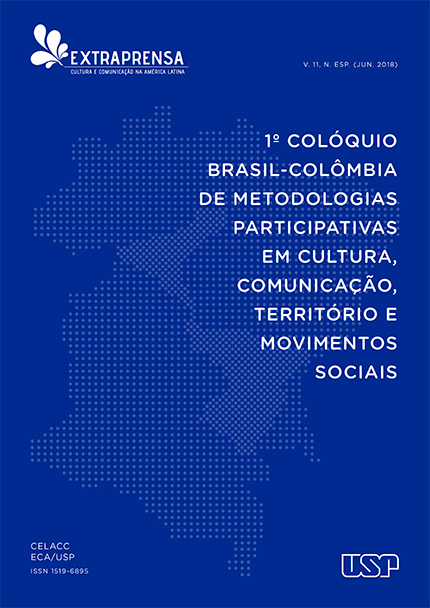The dominant logics in the repertoires of collective action of the city of periphery: a key reading of habitat from the proposal of the National Central Provivienda in Colombia
DOI:
https://doi.org/10.11606/extraprensa2018.145163Keywords:
Periphery Habitat, Social Struggles, Popular Habitat Logics, Urban TransformationsAbstract
The processes of the popular or the periphery habitat represent struggles and repertoires of collective action with an accumulated richness in research of knowledge, interpretations from different perspectives, and diverse methods of appropriation. Nevertheless, little has been said about their current spatio-temporal transformations. The processes of gentrification that now restore the pathways of popular habitat, and particularly, the logics that operate and have been inherent to the process of production of the city . The above mentioned are constituted , simultaneously, in the explanatory factors of the transformation and loss of the social fabrics that, once, enriched each one of the stages of the process of social production of the habitat. In this article, there is a methodological approach, and a proposal of analyses on habitat’s key of the transformations of the popular neighborhoods, from the interpretation of the logics of the need, of the State, and of the market, which operate in the definition of the singular paths of the neighborhoodDownloads
References
ABRAMO, Pedro. Teoría Económica de la favela: cuatro notas sobre la localización residencial de los pobres y el mercado inmobiliario informal. Ciudad y territorio: estudios territoriales. Madrid, n. 136, p. 273-294, 2003.
ARANGO, Carlos. Crónicas de la lucha por la vivienda en Colombia. Bogotá: Editorial Colombia Nueva, 1981.
ARCHILA NEIRA, Maurício. Idas y venidas, vueltas y revueltas: protestas sociales en Colombia, 1958-1990. Bogotá: Ediciones Ántropos, 2008.
CERTEAU, Michel de. La invención de lo cotidiano: artes de hacer. México: Universidad Iberoamericana, 2007, v. 1.
CLICHEVSKY, Nora. Informalidad y segregación urbana en América Latina: una aproximación, Santiago de Chile: Naciones Unidas, oct., 2000. (Medio Ambiente y Desarrollo, 28)
DUHAU, Emilio. Hábitat popular y política urbana. México: Universidad Autónoma Metropolitana, 1998.
DURÁN ACOSTA, Vanessa; MONTENEGROS CEBALLOS, Alexandra Milena. Partidas de inversión social regional. 2002. 235 f. TCC (Monografia en Ciencias Juridicas) - Facultad en Ciencias Jurídicas, Pontificia Universidad Javeriana, Bogotá. Disponible en: <http://hermes.javeriana.edu.co/biblos/tesis/derecho/dere4/Tesis-53.pdf>. Acceso en: 3 sep. 2017.
HARVEY, David. Espacio del capital: hacia una geografía crítica. Madrid: Ediciones Akal, 2009.
HERRERA, Diana Carolina Orozco. Lógica de las organizaciones populares de vivienda. Territorios, Medellín, n. 33, p. 191-206, ago. 2015.
LERA, Carmen et al. Trayectorias: un concepto que posibilita pensar y trazar otros caminos en las intervenciones profesionales en el trabajo social. Cátedra Paralela, Entre Ríos, n. 4, 2007.
LINDÓN, Alicia. La construcción social del territorio y los modos de vida en la periferia metropolitana. Territorios, Bogotá, n. 7, p. 27-41, enero 2002.
LINDÓN, Alicia. El mito de la casa propia y las formas de habitar. Scripta Nova, Barcelona, v. 9, n. 194, ago. 2005. Disponible en: <http://www.ub.edu/geocrit/sn/sn-194-20.htm>. Acceso en: 3 sep. 2017.
MESA SÁNCHEZ, Nora Elena. Proceso de desarrollo de los asentamientos no controlados. Los Pobladores: Protagonistas Urbanos En América Latina, Colombia, v. 6, fasc. p. 111-136, 1991.
NARANJO, María Elvira. Provivienda: protagonista de la colonización popular en Colombia. Hisotria y Memoria, Tunja, Colombia, n. 9, p. 89-118, jul.⁄dic. 2014.
PACHECO G., Margarida Rosa. Ejidos de Cali: siglo XIX. Cali: Universidad del Valle, [19-]. Disponible en: <http://bibliotecadigital.univalle.edu.co/bitstream/10893/7443/1/1.%20Ejidos%20de%20Cali%20siglo%20XIX%20-%20Pacheco%20Margarita.pdf>. Acceso en: 3 sep. 2017.
RODRÍGUEZ, María Clara. et al. Producción social del hábitat y políticas en el área metropolitana de Buenos Aires: historia con desencuentros. Buenos Aires: Instituto de Investigaciones Gino Germani, Facultad de Ciencias Sociales, UBA, 2007. (Documento de trabajo, 49).
SALAS, Pedro Antonio. En una noche amance un barrio. El Tiempo, Bogotá, 25 sept. 1998. Disponible en: <http://www.eltiempo.com/archivo/documento/MAM-753225>. Acceso en: 3 sep. 2017.
SANTOS, Milton. La naturaleza del espacio: técnica y tiempo, razón y emoción. Barcelona: Editorial Ariel, 2000.
SEGRE, Roberto. Tres décadas de reflexiones sobre el hábitat latinoamericano. Bogotá: Universidad Nacional de Colombia, 2005.
SEQUEIRA, Marta. La Sabana de Bogotá es dominable desde un avión, las montañas bogotanas desde una habitación. In: OBYRNE, Maria Cecília (ed.). Le Corbusier en Bogotá, 1947-1951. Bogotá: Ediciones Uniandes, 2010, p. 216-223.
SMITH, Neil. La nueva frontera urbana. Ciudad revanchista y gentrificación. Madrid: Traficantes de Sueños, 2012.
TORRES CARRILLO, Alfonso. Identidad y política de la acción colectiva: organizaciones populares y luchas urbanas en Bogotá, 1980-2000. Bogotá: Universidad Pedagógica Nacional, 2007.
Downloads
Published
Issue
Section
License
Ao submeter qualquer material científico para Extraprensa, o autor, doravante criador, aceita licenciar seu trabalho dentro das atribuições do Creative Commons, na qual seu trabalho pode ser acessado e citado por outro autor em um eventual trabalho, porém obriga a manutenção de todos os autores que compõem a obra integral, inclusive aqueles que serviram de base para o primeiro.
Toda obra aqui publicada encontra-se titulada sob as seguintes categorias da Licença Creative Commons (by/nc/nd):
- Atribuição (de todos os autores que compõem a obra);
- Uso não comercial em quaisquer hipóteses;
- Proibição de obras derivadas (o trabalho não poderá ser reescrito por terceiros. Apenas textos originais são considerados);
- Distribuição, exibição e cópia ilimitada por qualquer meio, desde que nenhum custo financeiro seja repassado.
Em nenhuma ocasião a licença de Extraprensa poderá ser revertida para outro padrão, exceto uma nova atualização do sistema Creative Commons (a partir da versão 3.0). Em caso de não concordar com esta política de Direito Autoral, o autor não poderá publicar neste espaço o seu trabalho, sob pena de o mesmo ser removido do conteúdo de Extraprensa.







